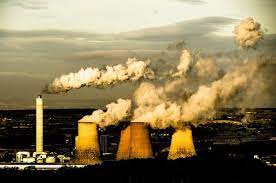Other Type of Environmental Pollution
Certain atoms are radioactive, meaning that they emit radioactivity during spontaneous transformation from an unstable isotope to a more stable one.
Radioactive pollution results from contamination of the environment with such substances, and may represent a significant health risk to humans and other organisms.
Radioactive pollution differs from much conventional pollution in that it cannot be detoxified or broken down into harmless substances. Instead, radioactive materials must be isolated from the environment until their radiation level has decreased to a safe level, a process which requires thousands of years for some materials.
What is Radioactive Pollution?
Radioactive pollution occurs when there is a presence or depositions of radioactive materials in the atmosphere or environment, especially where their presence is accidental and when it presents an environmental threat due to radioactive decay.
The destruction caused by the radioactive materials is because of the emissions of hazardous ionizing radiation (radioactive decay) like beta or alpha particles, gamma rays or neurons in the environment where they exist.
Radioactive pollution can also be defined as the increase in the natural radiation levels caused by human activities. It is estimated that about 20% of radiation we are exposed to is due to human activities.
The human activities that can release radiation involve activities with radioactive materials such as mining, handling and processing of radioactive materials, handling and storage of radioactive waste, as well as the use of radioactive reactions to generate energy (nuclear power plants), along with the use of radiation in medicine (e.g. X-rays) and research.
But what about microwaves, cell phones, radio transmitters, wireless devices, computers, and other common commodities of today‘s life?
When we think of radiation, we imagine bombs and nuclear explosions. While these are serious sources of high levels radiation (of high energy), there are many other sources that are much more common, practically ubiquitous, that generate low levels of radiation and which basically remain unnoticed.
How many of us think for example of cellular phones as a source of radiation? And yet, the cell phones, cell phone towers, cordless phones, as well as TVs, computers, microwave ovens, broadcast antennas, military and aviation radars, satellites, and wireless internet are all sources of radiation. And so are the common medical X-Rays.
Considering this, the picture of radiation pollution significantly expands. From a few explosions and nuclear accidents happening relatively rarely in faraway places, the picture of radiation pollution expands to a complex matrix covering all the Earth and thus involving all of us everywhere.
Radiation is essentially energy that travels and spreads out as it goes. This is referred to as electromagnetic radiation. Examples include visible light, radio waves, microwaves, infrared and ultraviolet lights, X-rays, and gamma-rays.

The differences between these various types of radiation consist of some physical properties such as energy, frequency, and wavelength. Thus, there are a variety of electromagnetic radiations.
This means that any and all these types of radiation can generate radiation pollution if they are enhanced by human activities.
However, the magnitude of the pollution generated varies, with higher-risk pollution generated by radiation of higher energy such as gamma-rays regardless of exposure time. This radiation is generated through detonation of nuclear weapons or in power plants.
Therefore, the meaning of radiation pollution is that, while there are ubiquitous sources of radiation, it is mostly the high-energy radiation that causes radiation pollution, carrying serious health risks (such as cancer or death).
This is why we will focus on sources for high health-risk radiation when discussing the causes of radioactive pollution and its effects.
Types of Radioactive Pollution
Based on the frequency with which it occurs, radioactive pollution can be continuous, occasional or accidental.
1. Continuous pollution
Continuous radioactive pollution is the type of pollution constantly coming from uranium mines, nuclear reactors, and test laboratories, where the radioactive contaminants are always present.
2. Occasional pollution
Occasional radioactive pollution is the type of pollution that occurs during nuclear tests or during experimental tests on radioactive substances.
3. Accidental pollution
Accidental radioactive pollution is the type of pollution that occurs when certain experiments involving dangerous substances fail, and the substances used for experimentation get out of control.
Examples of Radioactive Contaminants
Radioactive materials are those materials or elements that emit radiation, thus they are not stable and get transformed into other radioactive or non-radioactive materials.
The harm that they can cause depends on the radioactive elements and their half time function (the time needed for their concentration to be reduced to half due to radioactive decay processes). Basically, the higher the half-time, the lower the effects on human health.
Radioactive elements with a short and very short half-time pose a serious threat to human health because of their hazardous effects.
Most of the radioactive materials have half-lives of hundreds of thousands of years and, once generated, may persist in the environment for a very long time.
Many radioactive elements (materials) are naturally present in the environment. Most of them are used in nuclear power plants, and as basic components of nuclear weapons. Examples of this type of materials are:
CAESIUM-137: Used for radiation therapy in medicine (to treat cancer).
Read Also : Hurts Wastewater Management Complete Guide
STRONTIUM-90: Used for thermoelectric generators and portable power sources for space vehicles, weather stations etc.
PLUTONIUM 238: Used as a heat source for radioisotope thermoelectric generators.
URANIUM-235: Used as fuel for nuclear reactors.
COBALT-57 & 60: Used in nuclear medicine.
RADIUM-226: Used for lightning rods.
In summary, it is estimated that about 20% of radiation we are exposed to is due to human activities. Radioactive materials are those materials or elements that emit radiation.
Radioactive pollution differs from much conventional pollution in that it cannot be detoxified or broken down into harmless substances.
Radioactive pollution occurs when there is a presence or depositions of radioactive materials in the atmosphere or environment. The destruction caused by the radioactive materials is because of the emissions of hazardous ionizing radiation.



